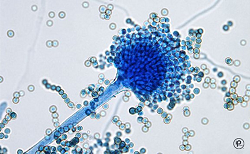-
Title
Description
-

Vascular coffee wilt or tracheomycosis is threatening the Ugandan coffee crop as it spreads from neighbouring Democratic Republic of Congo and infects more coffee producing regions. Also in Uganda, making money from honey. Plus, a report from Hong Kong on the World Bank meeting calling for more sustainable farming and how that will affect its lending.
Coffee Fungus Spreads into Uganda
BBC Radio 1997
-

Ecologist Lynne Boddy tells Bridget Kendall how fungi fight each other for resources and use “chemical warfare” to gain the upper hand.
-

Put any prejudices about poisonous toadstools and mould in damp corners out of your mind: this week’s Forum explores fungi as an extraordinarily tough and ecologically friendly building substance that could reshape our world. Plus the hundreds of thousands of species of fungi that have yet to be named and studied: some of them may hold vital clues on how to cure diseases or solve environmental problems. Bridget Kendall is joined by fungal ecologist Lynne Boddy, Danish mycologist and photographer Jens Petersen, and San Francisco-based artist, chef and fungal furniture-maker, Phil Ross. Above photo: Hygrocybe Psittacina Photo: © Jens H. Petersen. Below clip photo: Mycelium with Hyphal Strings
The Mysterious Kingdom of Fungi
BBC Radio 4 2013
-

Fungi are responsible for rotting fruit, crumbling brickwork and athlete’s foot. They have a mouldy reputation; but it’s their ability to destroy things that enables new life to grow. 90% of all plants depend on fungi to extract vital nutrients from the soil. And it’s probably thanks to fungi that the first plants were able to colonize land 450 million years ago. Professor Lynne Boddy shares her passion for fungi with Jim Al-Khalili and describes some of the vicious strategies they use to defend their territory. Direct strangulation and chemical weapons; it’s all happening underground.
BBC Radio 4 2016
-

Chris Sperring and Michael Jordan of the Association of British Fungus Groups go in search of giant bracket fungus in Dommett Wood in Somerset.
Bracket fungus grow on a variety of native trees. The vegetative part of the fungus, known as mycelium, grows under the bark of fallen wood or living trees, and will eventually break down and rot the host tree. However, the part that can most easily be seen is the fruiting body of bracket fungus. These fruiting bodies, growing on tree trunks and fallen logs, allow the fungus to reproduce and exist to produce and liberate millions of microscopic spores.
BBC Radio 4 2015
-

Scientist are unable to classify fungi as either plant or animal. They are just as likely to kill you as they are to feed you and their origins are difficult to trace.
-

Fungi Exploitation
Science is going back to basics …We look at how more than 28,000 strains of fungus held in the UK’s national collection are becoming the focus of research seeking new antibacterial drugs. The collection has great roots – it still holds an original sample of Sir Alexander Fleming’s penicillin. Quentin Cooper is joined by Dr Joan Kelley, Executive Director Bioservices, CABI and Professor Peter Bramley, Head of the School of Biological Sciences Royal Holloway, University of London.Fungi Exploitation – Electron Microscopes
February 2008 BBC Radio 4
-

Dr. Samir Agrawal, Barts Health NHS Trust, London, Fungal Update 2015, 10th Anniversary
-

Dr. Frank van de Veerdonk, Nijmegen, The Netherlands, Fungal update 2015, 10th Anniversary
